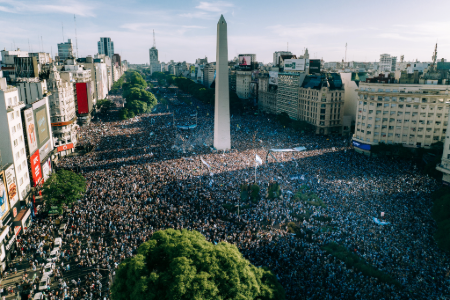After years of volatility, Argentina’s economic landscape is shifting, with fresh indicators pointing to a long-awaited revival. In April 2025, monthly inflation dropped to 2.8%, its lowest level in recent months, down from 11% in December 2024 (Reuters, May 14, 2025). As of May 2025, annual inflation remains high at 47.3%, but it has significantly declined from its peak of 211% by early 2024 (Reuters, January 11, 2024).
For the first time in a decade, Argentina's government posted a quarterly budget surplus (2025 Q1), signaling improved financial management. The peso is showing signs of stability, with the gap between the official exchange rate and the blue dollar narrowing, making trade and investments more predictable, and boosting market confidence. Additionally, the economy has been growing steadily for five consecutive months, reinforcing the market’s upward momentum.
Foreign investment is picking up. In April, Argentina secured a $20 million loan from the International Monetary Fund (IMF), reinforcing confidence among global investors. Meanwhile, the government approved a $2.5 billion lithium project by Rio Tinto, and thanks to fewer restrictions and clearer policies, more mining and energy investments are in the pipeline.
As Argentina begins to show signs of economic stabilization marked by a more stable currency, improving fiscal outlook, and renewed foreign investment, we see a strategic opportunity emerging.
INFLATION
Since 2018, Argentina has ranked among the world’s highest inflation economies, hitting a dramatic peak in 2023. Excessive money printing fueled the crisis, as the government financed subsidies, pensions, and wages without a corresponding rise in goods and services. As the peso lost value, people rushed to spend it, driving prices even higher. In December 2023, President Javier Milei launched a stabilization plan to control inflation and restore economic balance. The inflation has been falling and is currently at 2.8% per month, the lowest in a year. The key actions implemented to stabilize inflation were:
- Government Spending Cuts: The government significantly reduced subsidies, notably in energy and transportation. Additionally, they took steps to shrink government operations, freezing hiring and reducing the number of ministries.
- Tight Monetary Policy: The central bank raised interest rates, limited access to credit, and reduced monetary expansion by stopping the practice of money printing for fiscal shortfalls.
- Peso Stabilization: After years of rapid depreciation against the U.S dollar, multiple exchange rates, and the existence of a parallel market (blue dollar), President Milei and his economic team (led by Minister Luis Caputo) implemented measures to stabilize and restore confidence in the currency.
- The government allowed the peso to fluctuate, initially devaluing it to unify exchange rates across imports, exports, and tourism.
- Restrictions on buying/selling dollars are being gradually lifted.
- The central bank raised interest rates above inflation, incentivizing Argentinians to save in pesos rather than rush to convert them into dollars.
- Interest in peso-denominated assets, such as fixed-term deposits and sovereign bonds, has been growing steadily.
TOP SECTORS ON OUR WATCHLIST:
We are closely monitoring two key sectors in Argentina that have captured our attention: the energy sector, particularly oil & gas, and the financial sector.
- Energy & Oil/Gas: Argentina is leveraging its huge oil and gas reserves, particularly in the Vaca Muerta shale formation, by easing regulations to attract foreign investment. As a result, global energy firms are increasing exploration and production efforts, aiming to boost exports and generate foreign currency inflows. Additionally, companies now have improved access to the international credit market at lower interest rates, enhancing sector growth.
- Financial Sector: With inflation declining and the peso stabilizing, public confidence in banks is recovering. As a result, more people are saving in pesos and seeking loans, driving increased lending activity and profitability for financial institutions. Additionally, the government has eased regulations, facilitating investment and banking operations.
With clearer rules, stronger institutions, and rising investor interest, Argentina is moving from crisis to recovery, and from recovery to growth. The foundations are being laid for a healthier, more dynamic economy, and the world is beginning to see the first signs of a long-awaited recovery.
This opinion article was written on May 29, 2025, by the team of analysts at OTG Asset Management.
Disclosure: Foreign Investment Risk. Foreign investment risks include foreign security risk, foreign currency risk, and foreign sovereign risk. The prices of foreign securities may be more volatile than the prices of securities of U.S. issuers. In addition, changes in exchange rates and interest rates may adversely affect the values of the Fund’s foreign investments.
Latin America Risk. The Fund's performance is expected to be closely tied to social, political, and economic conditions within this region and may be more volatile than the performance of funds that invest in more developed countries and/or in more than one region.
Currency Risk. Currency conversion costs and currency fluctuations could erase investment gains or add to investment losses. Currency exchange rates can be volatile.

